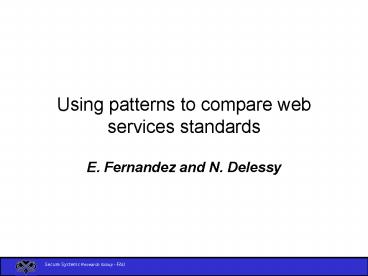Using patterns to compare web services standards - PowerPoint PPT Presentation
Title:
Using patterns to compare web services standards
Description:
WS enable the creation of new applications through web services composition ... an application could be a travel agency application that has to contact several ... – PowerPoint PPT presentation
Number of Views:37
Avg rating:3.0/5.0
Title: Using patterns to compare web services standards
1
Using patterns to compare web services standards
- E. Fernandez and N. Delessy
2
Introduction
- WS enable the creation of new applications
through web services composition - ? implement a Service-Oriented Architecture (SOA)
- involve a number of web services providers,
possibly from different organizations. - these providers may not even know each other in
advance, and could discover each other on the fly - ? security of these applications is challenging.
3
Introduction
- problem with WS security standards several
organizations are involved in developing them - ? there are many, and they may overlap
- Several commercial products,(web services
firewalls, XML VPNs, or identity management
solutions, ...) implement security for web
services - lack of clarity in the web services security
standards map ? difficult for vendors to develop
products that comply with standards and for users
to decide what product to use. - Users are also confused when selecting products
because it is not clear sometimes what standards
are supported by a given product.
4
Introduction
- We are developing a catalog of security patterns
- Another aspect how to compare standards using
patterns? - Using patterns
- we can verify if an existing product implementing
a given security mechanism supports some specific
standard. - a product vendor can use the standards to guide
the development of the product. - we can compare standards and understand them
better. For example, we can discover overlapping
and inconsistent aspects between them.
5
Web services security patterns
6
Comparing product architectures to standards
- Choose two aspects to compare from the diagram
(the implementation of a standard by a generic
product) - here the Application Firewall pattern and the
XACML Access Control Evaluation pattern
7
Application Firewall
8
XACML access control evaluation
9
Comparison
- the structure of the Application firewall pattern
is too simple to support a complex standard such
as XACML - the concepts of Policy Decision Point and Policy
Administration Point are included in the Policy
Authorization Point, - there is no way to handle descriptors for
subjects, objects, and predicates.
10
Comparing standards
- we choose a pair of standards to compare, we
consider XACML Policy Language against WS-Policy.
11
XACML Policy Language
12
WS-Policy
13
Comparison
- To compare two standards, we can look for
similarities in their context and in the problem
they solve. - When they are similar enough, we can compare the
way they solve the problem, balance their
respective advantages and liabilities.
14
Comparison
- These two patterns use policies to solve two
different problems. - Also, their context is different First,
WS-Policy is intended for securing Web Services,
whereas XACML is more general. - Second, an XACML policy is used by the
organizations Reference Monitor to control
access to an organizations resources (services
or documents) whereas a WS-Policy is bound to a
specific Web service endpoint. - A WS-Policy policy can be used to expose the web
services requirements and then can be used in
the access negotiation with the requester.
15
Comparison
- Therefore, XACML is to be used in a centralized
context in which one Reference Monitor controls
access to many web resources. For example, an
application firewall could use XACML policies,
(which are a subset of the XACML standard). - WS-Policy is to be used in a decentralized
context where each Web service provider has or
implements a Reference Monitor to control access
to it. For example, it could be used when an
application is built by automatically composing
web services from different organizations. Such
an application could be a travel agency
application that has to contact several flight
booking services, hotel reservation services,
16
Comparison
- The problem resolved by WS-Policy is similar to
the one solved by WSPL. - WSPL describes accesses as combinations of the
requester, the resource and the environments
attributes, whereas WS-Policy describes accesses
in terms of assertions, which is an extensible
concept. - Another standard, defined by the same committee,
WS-SecurityPolicy, extends WS-Policy and defines
the integrity and the confidentiality assertions
which can correspond to some environments
attributes in XACML. - Also, the security token defined in WS-Security
can correspond to a users attribute.
17
Comparison
- However, minor dissimilarities exist between
these two standards in terms of - Attributes/assertion operators WSPL allows a
wide range of comparisonswhereas WS-Policy - negative policies (only WSPL),
- the concept of obligation (only WSPL),
- the definition of the semantics for
attributes/assertions An Assertion may be a
complex XML type, it is domain-dependent. WSPL
assertions are from standards data types, and
are extensible thus can be processed
automatically.
18
WS-Security
19
WS-
20
Conclusion
- In the future we will continue to compare
standards against each other. - We also need to develop more patterns to
describe standards such as SAML and others.































